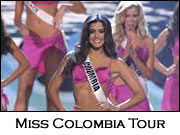MAIL-ORDER BRIDE INDUSTRY
AND ITS IMPACT ON U.S. IMMIGRATION
Robert J. Scholes, PhD with
the assistance of Anchalee Phataralaoha, MA
This research was funded under
purchase order COW-8-P-0233 from the Immigration and
Naturalization Service. The analyses and conclusions presented
do not necessarily represent the official position or policy
of the Immigration and Naturalization Service.
|
The Industry
An American man seeking a foreign bride
may avail himself of over 200 different services in which foreign women
advertise for husbands. There are two types of such services. In one
type, the so-called "mail-order bride" industry
(representatives of the industry prefer the term "international
correspondence service"), women's names, photos, biographical
sketches, and addresses are presented in hard copy brochures or on the
Internet. In these services, the agency provides the photos and
descriptions of the women, who are not charged for this listing. Men who
wish to obtain the mailing address of any of the women they would like
to contact are charged a fee of from $2 to $5 for each of the mailing
addresses.
The other way to contact potential
spouses is through e-mail "pen-pal" clubs. These services are
generally free of charge. In them, men and women provide biographical
data, an e-mail address, and an indication of what type of relationship
they seek. Some of the larger, more established of these pen-pal clubs
are One-And-Only.com, Friendfinder.com, Match.com, Kiss.com, and
Date.com. In these clubs, one can find nearly 10,000 foreign women
seeking marriage or long-term relationships. Since these services
require access to computers, the women tend to be older and better
educated than those listed in the "mail-order bride" catalogs
and to reside in more developed countries such as Japan and Russia.
The women are obtained through
advertisements in local newspapers and popular women's magazines and,
most commonly, through word of mouth.
Based on a scanning of the services
listed and information provided by the agencies themselves, we may
estimate that between 100,000 and 150,000 women from a variety of
countries (including the United States, Canada, Europe, and Australia)
annually advertise themselves as available for marriage. The great
majority of these women are from two major areas: Southeast Asia,
including the Philippines, and Russia and other countries of the former
Soviet Union.
The Philippines provides a large number
of the Asian listings, despite the fact that "mail-order
bride" activities have been illegal there since 1986, while
Thailand, China, Indonesia, Malaysia, Korea, and Japan are also seen
often as the woman's native country.
In recent years, a large increase in
listings has been due to the influx of services focused on women of
Russia and the former Soviet Union. Nearly half (69) of the 153 services
listed in one source feature such women. In addition to Russia itself,
the Ukraine is the most common country of origin.
The agencies vary considerably in the
number of women listed, the geographical origin of the women, and in the
length of time they have been in business. One of the largest and oldest
of them is Cherry Blossoms, which has been operating since 1974 and
lists over 6,000 women at any one time. This company's listings reflect
the general pattern of national origin of the women seeking husbands: of
the 6,000, over 4,600 are from Asia (3,050 from the Philippines), 1,700
from the former Soviet Union (mostly from Russia and Ukraine), and
others from Latin and South America and Europe.
These businesses can be highly
profitable. Bob Burrows, president of Cherry Blossoms, reports that his
agency serves over 1,000 men per month who pay up to $200 each.
The growth of these services has been
phenomenal. Glodava and Onizuka (1994) report that there were 100 such
companies in existence at the time of their writing. In mid-March of
1998, when work on this present report began, there were 153 listings in
goodwife.com and in early May, less than two months later, there were
202. This list of links breaks down the agencies into four
sections--Asian, Latin, Multi-ethnic, and Soviet--based on where most of
the women currently reside. As can be seen in the table below, the
current rapid growth is due largely to agencies representing women from
Russia and the former Soviet Union.
|
|
March, 1998
|
May, 1998
|
|
Asian
|
38
|
55
|
|
Latin
|
20
|
24
|
|
Multi-ethni
|
26
|
28
|
|
Soviet
|
69
|
105
|
|
Total
|
153
|
202
|
The Women
An analysis of the listings in recent
issues of five popular catalogs featuring 1,400 Asian women found that
70 percent were Filipino (despite the fact that Republic Act No. 6955
makes such listings illegal), many of whom are "in-service" as
domestic workers in other countries, 16 percent Indonesian, 8 percent
Thai, 2 percent Malaysian and Japanese, and 1 percent Chinese and
Korean. In terms of age, 20 percent are 16-20 years of age, 41 percent
are 21-25, 24 percent are 26-30, 11 percent 31-35, and just 4 percent
are over the age of 35. That is, for the Asian women, 61 percent are
under the age of 25. There is a large difference in ages between these
Asian women and their counterparts from the former Soviet Union. For the
1,700 Soviet women listed currently by Cherry Blossoms, just 8 percent
are under 20, 23 percent between 21 and 25, 25 percent between 26 and
30, 20 percent from 31 to 35, 14 percent from 36 to 40, 7 percent aged
41 to 45, and 3 percent over 45. That is, just 31 percent are under 25
compared to the 61 percent of Asian women.
Why do foreign women want American
husbands? Many sources suggest that these women are searching for a
"better life" in terms of socio-economic factors--they do, for
the most part, come from places in which jobs and educational
opportunities for women are scarce and wages are low. However, when the
women themselves are asked this question, the answer generally indicates
an attraction to American men (they look like movie stars) and an
aversion to native men. Americans, they say, make good husbands while
Filipino (Thai/Indonesian/Russian/etc.) men do not. Americans are
thought to be faithful to their wives, while the native men are cruel
and run around with other women. True or not, this is the perception.
The Men
David Jedlicka (1988, cited in Glodava
and Onizuka, 1994) surveyed 607 American men seeking mail-order brides
and received 206 responses. He found that the men were generally white
(94 percent); highly educated (50 percent with two or more years of
college, 6 percent with M.D.'s or Ph.D.'s, only five did not complete
high school); politically and ideologically conservative; and generally
economically and professionally successful (64 percent earned more than
$20,000 a year; 42 were in professional or managerial positions). Their
median age was 37. The men came from 44 states, with 22 percent from
California, and 84 percent lived in metropolitan areas. Fifty-seven
percent had been married at least once; most had been divorced after an
average of seven years of marriage, 35 percent had at least one child,
and 75 percent wished to father additional children. When asked about
their religious affiliations, 48 percent of the men identified
themselves as Protestant, 23 percent as Catholic, 15 percent as
belonging to other religions, and 14 percent as having no religious
affiliation.
Why do American men want foreign wives?
Most of the personal reports from American men who have married women
through these agencies talk about "traditional values." That
is, American women are thought not content to be wives and mothers but
seek personal satisfaction through their own careers and interests,
while the foreign woman is happy to be the homemaker and asks for
nothing more than husband, home, and family. Again, true or not, this is
the perception.
Although Jedlicka states in his
conclusions that his research shows the men who choose the mail-order
methods for mate selection appear ". . . above average . . .
certainly in their communication skills," and "exceptional in
the sense that they are trying cross-cultural marriage to improve their
chances for loving and enduring relationships," he cautions that
such conclusions are thin at best and such interpretations from these
data are not warranted. His experience and the observations of others
show that, contrary to responses in questionnaires, those who have used
the mail-order bride route to find a mate have control in mind more than
a loving, enduring relationship.
Of the 30 mail-order bride couples Mila
Glodava (Glodava and Onizuka, 1994) encountered between 1986 and 1993,
only two were close in age (4 -6 years difference). In the other 28
there was a 20 to 50 year difference in age. Older men, says Glodava,
often want women "they can mold" and therefore do not want
those who are too educated. "They would just become like any other
American woman," they said. She concludes that, "It is
apparent that power and control are critical for the men."
It is interesting to note that the views
above on native and foreign men and women are not limited to the
Occident--a similar attitude exists in Taiwan. According to "Taiwan
Moves to Boost Women's Marriage Prospects" (The Associated Press,
Aug. 30, 1996, by Annie Huang), many Taiwanese men prefer brides from
other Asian countries because they feel Taiwanese women--who tend to be
better educated and more affluent--expect too much from their husbands.
Due to this attitude, Taiwan has imposed a limit on the number of brides
from certain countries that can enter Taiwan each year--360 from
Indonesia, 420 from Burma, and 1,080 from China. On the women's side,
many of them are seeking Western men since, they say, Taiwanese men want
to marry only hard-working obedient drudges while Taiwanese women have
discarded this traditional role and are seeking equality and mutual
respect in marriage.
Success Rates for International Services
In a survey done for this report we sent
e-mails to 102 of the services and received replies from 28. We asked
what percentage of their female clients married U.S. men.
Few agencies kept any records of
engagements or marriages; some because they are too new for their
clients to have had time to marry, some because they have no interest in
following up on their listings. Of those that provided estimates of
marriages, the ones listing predominately women from Russia and the
former Soviet Union countries provided the highest figures--10 percent
to 40 percent. Those whose women were largely from the Philippines and
Asian countries gave lower estimates--none to 5 percent. In most cases,
these estimates were for marriages to men from any country, not
specifically the United States.
The only agency that provided firm
statistics was Encounters International. This agency has been in
business since 1993 and presents 450 Russian women in its current
listing. They report 102 marriages to date between Russian women and
U.S. men and, in addition, keep records of births, divorces, and
locations of the couples. If it is assumed that the agency's listings
have remained relatively constant at about 500 women each of the five
years of its existence, then 102 of the 2,500 women, or approximately 4
percent, have found and married American men.
According to a report from the
Commission on Filipinos Overseas (Paredes-Maceda, 1995) mail-order
brides constitute 10 percent of the marriages between Filipinos and
foreign nationals. Between 1989 and 1994, 95,000 Filipino men and women
were engaged to be married to foreigners, the great majority of whom met
their partners through work or personal introductions. Of the foreign
men who married Filipinos, 44 percent were U.S. citizens.
According to the women themselves (in
written replies to a 1996 questionnaire from the author), approximately
10 percent of these women are successful--they find and marry a man
through the service. There are, then, around 10,000 marriages a year
between women listed by these agencies and men who use the services. Of
these 10,000, around 4,000 involve U.S. men. The remainder is
distributed among Canadian, Australian, European, and, increasingly,
Japanese clients.
Based on these data, we may estimate
that 4 percent of the 100,000 to 150,000 women seeking U.S. husbands
through international services find them; that is, "mail-order
bride" and e-mail correspondence services result in 4,000 to 6,000
marriages between U.S. men and foreign brides each year.
This figure, 4,000 to 6,000, represents
an increase from previous estimates (e.g., the estimate of 2,000 to
3,500 given by Kadohata, 1990) due, no doubt, to the recent increase in
both e-mail correspondence services and the agencies specializing in
Russian and Ukrainian women.
Impact on U.S. Marriages
According to data supplied by the U.S.
Census Bureau, there were 2,395,000 marriages in the U.S. in the 12
months ending June, 1997 (and 1,154,000 divorces in the same period).
The 4,000 to 6,000 marriages involving international services represent,
then, a tiny portion (.021 percent) of the women who marry U.S. men.
It is interesting to note that, based
largely on data provided by the agencies themselves (along with the
Commission on Filipinos Overseas report cited above), marriages arranged
through these services would appear to have a lower divorce rate than
the nation as a whole, fully 80 percent of these marriages having lasted
over the years for which reports are available.
Impact on U.S. Immigration
Statistics provided by the Immigration
and Naturalization Service for the years 1994-96 show that there have
been over 800,000 immigrants per year, of whom about 18 percent enter as
spouses of U.S. citizens; e.g., 169,760 of 915,900 in 1996. An
additional 14 percent (130,000) of the total immigrants involves parents
and children of U.S. citizens.
In any case, the 4,000 to 6,000 women
who immigrate through international correspondence agencies represent
less than 6 percent of the new citizens. The majority of the women who
gain permanent resident alien status through marriage do so through more
traditional means, such as by meeting their spouse at work or in school
or through marriage to U.S. servicemen stationed overseas.
Both U.S. citizens and permanent
resident aliens may petition for their spouses. While spouses and minor
children of citizens may enter without long waits once the paperwork is
approved, entry for spouses and minor children of permanent resident
aliens is regulated by annual ceilings. In 1996 about 54,000 spouses
were sponsored by permanent resident aliens.
The most common times for mail-order
brides to leave the marriage, according to Martin (n.d.) are
"immediately, 3 months after marriage (receipt of the green card),
and 2 years after marriage (receipt of nonconditional permanent
residence)."
There are reports of a different kind of
fraud--namely, one in which women are recruited into prostitution
through the international matchmaking services. This new slave trade has
not, however, to the author's knowledge, occurred in the United States,
although it is a well documented trade involving Russian women imported
into Israel (Specter, 1998).
Abuse
According to "The Health Care
Response to Domestic Violence" (anon. 1994), "Within the last
year 7 percent of American women (3.9 million) who are married or are
living with someone as a couple were physically abused, and 37 percent
(20.7 million) were verbally or emotionally abused by their spouse or
partner."
While no national figures exist on abuse
of alien wives, there is every reason to believe that the incidence is
higher in this population than for the nation as a whole. Authorities
agree that abuse in these marriages can be expected based on the men's
desire for a submissive wife and the women's desire for a better life.
At some point, after the alien bride has had time to adjust to the new
environment, to make new friends, and to become comfortable with the
language, her new independence and his domination are bound to conflict.
The problem, according to Mila Glodava (Glodava and Onizuka, 1994) and
Uma Narayan (Narayan, 1995), is largely due to the men's unrealistic
expectations. While many state a desire for a submissive wife, they find
that such dependence becomes a burden. To provide some relief, the
husband seeks ways (friends, activities) that will get the wife
"out of the house" on occasion. The resulting independence
then angers the husband who manifests the anger on the wife, who may
have only been guilty of trying to please her husband.
Current INS Regulations
Immigration law concerning marriage to
foreign nationals contains numerous safeguards discouraging abuse of
this means of gaining U.S. permanent residence alien status. In general,
the couple must be serious enough to wait for several months, to file a
number of forms, and to pay sizeable fees.
The procedures, as outlined by the U.S.
Department of State Bureau of Consular Affairs, are as follows.
The Immigration and Nationality Act, as
amended, provides U.S. citizens with two options for facilitating the
immigration of future spouses to the United States: the K-1 fianc� visa
and the alien-spouse immigrant visa. In many cases, the processing time
for a fianc� visa is shorter than that for an alien spouse. Fianc�(e)
visa processing can take several months from the filing of the petition
to the final adjudication of the visa. Total processing time for the
alien-spouse visa can take 6-12 months depending on individual
circumstances. While the immigrant visa route may take longer,
additional processing in the United States is not required, as is the
case for the fianc�(e) visa.
Marriage In the United States: Fianc�(e)
Visa
U. S. citizens may file an I-129F
petition with INS for the issuance of a K-1 fianc�(e) visa to an alien
fianc�(e). A citizen exercising this option must remain unmarried until
the arrival of the fianc�(e) in the United States, and the wedding must
take place within 3 months of the fianc�(e)'s arrival if he/she is to
remain in status. Also, the alien and U.S. citizen must have met
personally at least once in the 2 years before the petition was filed.
For more information about K-1 visas see the Bureau of Consular Affairs'
brochure Tips For U. S. Visas: Fianc�(e)s. Legal permanent
residents may not file petitions for fianc�(e) visas. They must
marry abroad and then file an I-130 petition for the immigration of a
new spouse.
Marriage Abroad: Alien Spouse Visa
If a U.S. citizen marries an alien
abroad, an I-130 petition must be filed after the marriage to begin the
immigration process for the alien spouse. This can be filed either with
the Immigration and Naturalization Service (INS) in the United States,
or, under certain circumstances, at U.S. Embassies or Consulates abroad.
U. S. Embassies and Consulates have differing policies on approving
I-130s and should be individually contacted about the availability of
this service. Many posts have their own web pages which include this
information and which can be accessed through the U.S. Embassy and
Consulate links page. Prior to departure from this country the U.S.
citizen should contact the INS or appropriate foreign service post to
ascertain exactly what documents will be necessary to file the immigrant
petition for a new spouse. For more information about this option, see
the Bureau of Consular Affairs' brochure Tips for U.S. Visas:
Family-Based Immigrants. For more information on how to arrange a
legally valid marriage abroad, see the Office of Citizens' Consular
Services brochure Marriage of U.S. Citizens Abroad.
Procedurally, the process works like
this. The U.S. citizen or permanent resident must submit a visa petition
(form I-130) to appropriate local INS office to prove that the marriage
is bona fide, that is, entered into for love rather than simply
for the foreign-born spouse to obtain a green card. Attached to the visa
petition are the following items: (1) Biographical forms (forms G-325A)
for both the husband and the wife with photos attached; (2) Proof of the
citizenship status of the petitioner. This can take the form of a U.S.
passport, a Certificate of Naturalization or Citizenship or a certified
copy of the citizen's birth certificate; (3) A certified copy of the
marriage certificate; (4) Certified copies of the documents that
terminated any previous marriages of the husband or wife, including
final divorce decrees, and certificates of annulment or death; and, in
the case of a permanent resident alien, proof of such status.
Simultaneously, the foreign-born spouse must submit an application for
adjustment of status (form I-485) which is an application for a green
card. Items which must accompany the green card application are a
completed fingerprint chart and green card photographs, and other INS
forms may be required. The spouse can also file an OF-230 with the
consulate and be issued an immigrant visa. In both the immigrant visa
and adjustment of status cases, the petitioning U.S. citizen or Legal
Permanent Resident must also complete an affidavit of support, INS form
I-864, on behalf of the alien spouse.
In the case of a mail-order bride, a
permanent resident alien would most likely marry the person abroad and
then file the I-130. It would be possible for the woman to enter as a
visitor or in another nonimmigrant category so the marriage could occur
in the United States. The U.S. citizen spouse would then file the I-130
and the bride would file for adjustment of status using INS form I-485.
Conditions
If the marriage is less than 2 years old
when the foreign-born spouse becomes a permanent resident, the green
card will expire after a two-year period. Both spouses must submit a
joint petition (form I-751) to remove the two-year condition within the
90-day period immediately preceding the end of the two-year period. Upon
removal of conditions, a new green card is issued reflecting permanent
resident status.
If the marriage has terminated by reason
of divorce, death of the citizen spouse or spousal abuse, the
foreign-born spouse may apply for a waiver of the joint petition
requirement.
Recent Changes
Before 1986, when a citizen married a
foreigner and petitioned for the spouse, the spouse was granted
permanent residence fairly quickly and more or less as a matter of
course. In 1986, as a result of concerns about alleged marriage fraud,
Congress passed the Immigration Marriage Fraud Amendments (IMFA), which
changed the legal process. Thereafter, the U.S. citizen had to petition
for what is called "conditional resident status" for the
spouse. The couple then had to wait for 2 years after conditional
resident status obtained during which time they had to remain married,
and then jointly petition INS to adjust the conditional status to
that of permanent residence. Both spouses had to undergo a personal
interview with the INS, to prove that the marriage was a bona fide
one, before permanent resident status was conferred on the spouse
(Anderson 1993). The two-year waiting period to apply for permanent
resident status required by IMFA begins on the date the spouse obtains
conditional resident status. Administrative delays can continue for four
years or more.
In 1989, the House Judiciary Committee
on Immigration, Refugees and International Law held a hearing on
domestic violence in marriages between American citizens and foreigners.
Representative Louise M. Slaughter testified that many battered
conditional residents had no viable legal options. She introduced a
bill, passed in 1990, which provided that battery and extreme cruelty,
if alleged and proven, could qualify a conditional resident for a waiver
during the waiting period. Initiation and termination of divorce
proceedings was not required, if abuse could be proven. This legislation
also terminated the condition that the divorce had to be for a
"good cause." It held that the termination of a "good
faith" marriage involving a conditional resident could itself
constitute a waiver, without regard to the reasons for the divorce.
The petitioner, however, must present
other evidence to support the application for waiver based on a claim of
having been battered or subjected to extreme cruelty. Evidence may
include, but is not limited to, expert testimony in the form of reports
and affidavits from police, judges, medical personnel, school officials
and social service agency personnel. The Service must be satisfied with
the credibility of the sources of documentation submitted in support of
the application.
Recommendations
Current INS rules and policies seem well
intentioned in that they allow U.S. citizens and permanent residents to
marry and bring to this country alien spouses while providing some
safeguards against abuse and fraud.
The existing problems that appear to
require some attention involve abuse. On the one hand, the potential
husbands might need to be screened. As Sumiko Hennessy, executive
director of the Asian Pacific Development Center (anon., 1996), notes,
"What you have are older men, people with three divorces, alcohol
problems . . .," some of whom have a history of "domestic
abuse or problems with the law." To this end, I would strongly
recommend that Uma Narayan (Narayan, 1995) be consulted before any new
legislation focused on abuse and/or fraud is considered.
At the very least, alien spouses should
be informed of their rights and be given names, addresses, and telephone
numbers of agencies they may consult if they face difficulties in the
marriage, agencies such as: Legal Aid for Abused Women and Children
(703) 820-8393; AYUDA (202) 387-4848; National Coalition Against
Trafficking in Women (814) 685-1447; NOW (707) 255-2516; and the Asian
Pacific Development Center (303) 220-3398.
Back to top
|

 2020 Best International
2020 Best International  2020 Best Affiliate Program
2020 Best Affiliate Program
 2020 Best Niche Dating Site
2020 Best Niche Dating Site
 2019 Best International
2019 Best International  2018 Best Affiliate Program
2018 Best Affiliate Program
 2016 Best Niche Dating Site
2016 Best Niche Dating Site
 2014 Best Niche Dating Site
2014 Best Niche Dating Site
 2014 Best Affiliate Program
2014 Best Affiliate Program




















